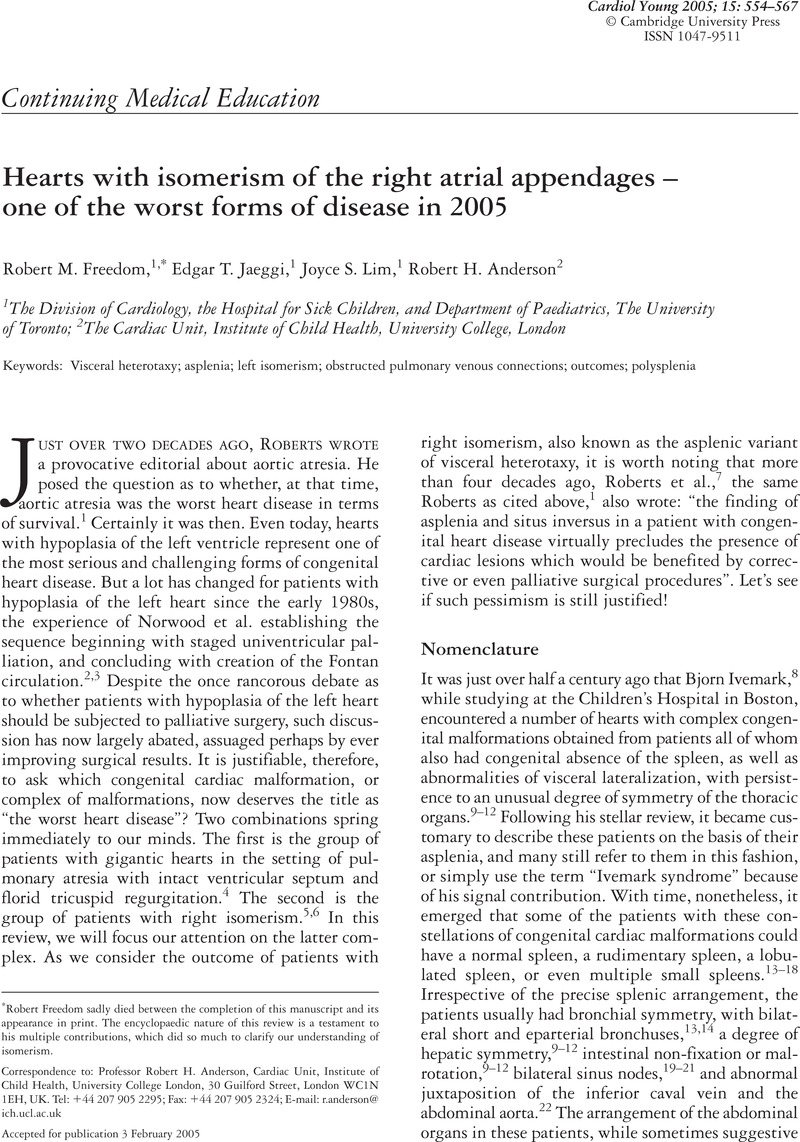Crossref Citations
This article has been cited by the following publications. This list is generated based on data provided by Crossref.
Anderson, Robert H.
2006.
Solving the disputes concerning the congenitally malformed heart.
Progress in Pediatric Cardiology,
Vol. 22,
Issue. 2,
p.
147.
Freedom, Robert M.
Jaeggi, Edgar
Perrin, Don
Yoo, Shi-joon
and
Anderson, Robert H.
2006.
The “wall-to-wall” heart in the patient with pulmonary atresia and intact ventricular septum.
Cardiology in the Young,
Vol. 16,
Issue. 1,
p.
18.
Yildirim, Selman Vefa
Tokel, Kürsad
Varan, Birgül
Aslamaci, Sait
and
Ekici, Enver
2007.
Clinical investigations over 13 years to establish the nature of the cardiac defects in patients having abnormalities of lateralization.
Cardiology in the Young,
Vol. 17,
Issue. 3,
p.
275.
Fischer, Abigail
Long, Fredrick
and
Feltes, Timothy F.
2007.
Hepatic necrosis following repair of totally anomalous pulmonary venous connection.
Cardiology in the Young,
Vol. 17,
Issue. 4,
p.
435.
Matsuura, Keiko
Akizuki, Shinichiro
Nakamura, Natsuki
Ishibashi-Ueda, Hatsue
and
Moriyama, Masatsugu
2007.
A Case of Right Isomerism Showing Long Survival Without Surgery.
Southern Medical Journal,
Vol. 100,
Issue. 2,
p.
218.
Wu, Mei-Hwan
Wang, Jou-Kou
Lin, Jiunn-Lee
Lin, Ming-Tai
Chiu, Sheun-Nan
and
Chen, Chun-An
2008.
Long-term outcome of twin atrioventricular node and supraventricular tachycardia in patients with right isomerism of the atrial appendage.
Heart Rhythm,
Vol. 5,
Issue. 2,
p.
224.
Yoo, Shi-Joon
and
Jaeggi, Edgar
2008.
Ultrasonography in Obstetrics and Gynecology.
p.
511.
Yan, Ying-Liu
Tan, Kenny BL
and
Yeo, George SH
2008.
Right Atrial Isomerism – Preponderance in Asian Fetuses. Using the Stomach-distance ratio as a Possible Diagnostic Tool for Prediction of Right Atrial Isomerism.
Annals of the Academy of Medicine, Singapore,
Vol. 37,
Issue. 11,
p.
906.
Yoo, Shi-Joon
Friedberg, Mark K
and
Jaeggi, Edgar
2008.
Fetal Cardiology.
p.
347.
Lytrivi, Irene D.
and
Lai, Wyman W.
2009.
Echocardiography in Pediatric and Congenital Heart Disease.
p.
476.
Webber, Steven A.
Uemura, Hideki
and
Anderson, Robert H.
2010.
Paediatric Cardiology.
p.
463.
Kaasinen, E.
Aittomaki, K.
Eronen, M.
Vahteristo, P.
Karhu, A.
Mecklin, J.-P.
Kajantie, E.
Aaltonen, L. A.
and
Lehtonen, R.
2010.
Recessively inherited right atrial isomerism caused by mutations in growth/differentiation factor 1 (GDF1).
Human Molecular Genetics,
Vol. 19,
Issue. 14,
p.
2747.
Sano, Shunji
Fujii, Yasuhiro
Arai, Sadahiko
Kasahara, Shingo
and
Tateishi, Atsushi
2012.
Atrioventricular Valve Repair for Patient With Heterotaxy Syndrome and a Functional Single Ventricle.
Seminars in Thoracic and Cardiovascular Surgery: Pediatric Cardiac Surgery Annual,
Vol. 15,
Issue. 1,
p.
88.
Ota, Noritaka
Fujimoto, Yoshifumi
Murata, Masaya
Tosaka, Yuko
Ide, Yujiro
Tachi, Maiko
Ito, Hiroki
Sugimoto, Ai
and
Sakamoto, Kisaburo
2012.
Improving Outcomes of the Surgical Management of Right Atrial Isomerism.
The Annals of Thoracic Surgery,
Vol. 93,
Issue. 3,
p.
832.
Marino, Bruno
Versacci, Paolo
Guccione, Paolo
and
Carotti, Adriano
2012.
Pediatric Cardiovascular Medicine.
p.
702.
Niszczota, Cezary Sebastian
and
Koleśnik, Adam
2012.
Morfologia kliniczna wad spływów żył płucnych i systemowych.
Pediatria Polska,
Vol. 87,
Issue. 3,
p.
293.
Eronen, Marianne P.
Aittomäki, Kristiina A. U.
Kajantie, Eero O.
Sairanen, Heikki I.
and
Pesonen, Erkki J.
2013.
The Outcome of Patients With Right Atrial Isomerism is Poor.
Pediatric Cardiology,
Vol. 34,
Issue. 2,
p.
302.
Suman-Horduna, Irina
Babu-Narayan, Sonya V.
Ueda, Akiko
Mantziari, Lilian
Gujic, Marko
Marchese, Procolo
Dimopoulos, Konstantinos
Gatzoulis, Michael A.
Rigby, Michael L.
Yen Ho, Siew
and
Ernst, Sabine
2013.
Magnetic navigation in adults with atrial isomerism (heterotaxy syndrome) and supraventricular arrhythmias.
EP Europace,
Vol. 15,
Issue. 6,
p.
877.
Burton, Elizabeth C.
Olson, Michelle
and
Rooper, Lisa
2014.
Defects in Laterality with Emphasis on Heterotaxy Syndromes with Asplenia and Polysplenia: An Autopsy Case Series at a Single Institution.
Pediatric and Developmental Pathology,
Vol. 17,
Issue. 4,
p.
250.
Escobar-Diaz, Maria C.
Friedman, Kevin
Salem, Yishay
Marx, Gerald R.
Kalish, Brian T.
Lafranchi, Terra
Rathod, Rahul H.
Emani, Sitaram
Geva, Tal
and
Tworetzky, Wayne
2014.
Perinatal and Infant Outcomes of Prenatal Diagnosis of Heterotaxy Syndrome (Asplenia and Polysplenia).
The American Journal of Cardiology,
Vol. 114,
Issue. 4,
p.
612.



